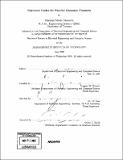Universal codes for parallel Gaussian channels
Author(s)
Modir Shanechi, Maryam
DownloadFull printable version (4.480Mb)
Other Contributors
Massachusetts Institute of Technology. Dept. of Electrical Engineering and Computer Science.
Advisor
Gregory W. Wornell and Uri Erez.
Terms of use
Metadata
Show full item recordAbstract
In this thesis we study the design of universal codes for parallel Gaussian channels with 2 sub-channels present. We study the universality both in terms of the uncertainty in the relative quality of the two sub-channels for a fixed maximum rate, C*, and in terms of the uncertainty of the achievable maximum rate. In our architecture, we will convert the parallel Gaussian channel into a set of scalar Gaussian channels and use good base codes designed for the corresponding scalar channel in the coding schemes. In Chapter 2, a universal layered code with deterministic dithers is developed. The code is repeated across the two sub-channels with possibly different dithers. Symbols in each of the layer codewords can be combined using unitary transformations of dimension, m. A minimum mean squared error (MMSE) receiver combined with successive cancellation is used for decoding. We show that increasing m does not improve the efficiency. The efficiency increases by adding more layers up to a certain number and after that it saturates. We find an expression for this saturation efficiency. We show that partial CSIT improves the efficiency significantly. At the end we compare the performance of maximal ratio combining (MRC) and MMSE receivers and show that they are close in the coding scheme with no CSIT. In Chapter 3, we design an alternative universal code and extend it to be rateless. This is a sub-block structured code symmetric with respect to all layers that gets repeated across the two sub-channels and in time using i.i.d. Bernoulli (1/2) dithers. The decoder uses an MRC receiver combined with successive cancellation. We prove that in the limit of large L when L is increased exponentially with C*, the code is capacity achieving. We perform efficiency analyses when L is scaled linearly with C* and derive upper and lower bounds on the efficiency. We also show that the scheme has high efficiencies for practical ranges of C* using a low-rate good base code. We discuss the unknown time-varying behavior of the scheme and at the end briefly discuss the use of faster than Nyquist signaling to enable the scheme to have a high efficiency for higher C* values.
Description
Thesis (S.M.)--Massachusetts Institute of Technology, Dept. of Electrical Engineering and Computer Science, 2006. Includes bibliographical references (p. 97).
Date issued
2006Department
Massachusetts Institute of Technology. Department of Electrical Engineering and Computer SciencePublisher
Massachusetts Institute of Technology
Keywords
Electrical Engineering and Computer Science.